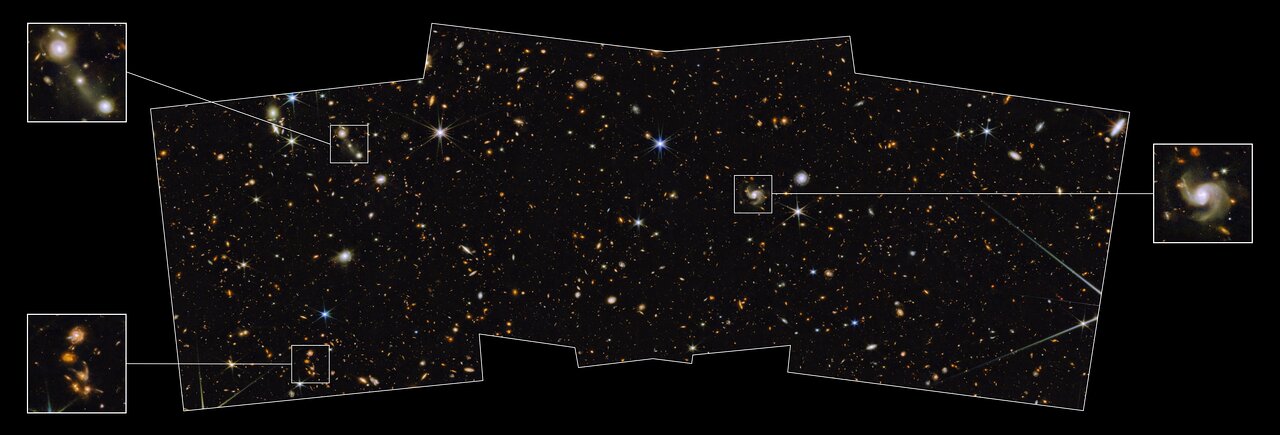James Webb Space Telescope Discovery
Clicking on each image will open the full resolution one. Try it!Clicking on "Raw images" image will yield all the relevant raw images.
Webb Glimpses Field of Extragalactic PEARLS, Studded With Galactic Diamonds
The NASA/ESA/CSA James Webb Space Telescope has captured one of the first medium-deep wide-field images of the cosmos, featuring a region of the sky known as the North Ecliptic Pole. The image, which accompanies a paper published in the Astronomical Journal, is from the Prime Extragalactic Areas for Reionization and Lensing Science (PEARLS) GTO program.
“Medium-deep” refers to the faintest objects that can be seen in this image, which are about 29th magnitude (1 billion times fainter than what can be seen with the unaided eye), while “wide-field” refers to the total area that will be covered by the program, about one-twelfth the area of the full moon. The image is composed of eight different colors of near-infrared light captured by Webb’s Near-Infrared Camera (NIRCam), augmented with three colors of ultraviolet and visible light from the NASA/ESA Hubble Space Telescope. This beautiful color image unveils in unprecedented detail and to exquisite depth a universe full of galaxies to the furthest reaches, many of which were previously unseen by Hubble or the largest ground-based telescopes, as well as an assortment of stars within our own Milky Way galaxy. The NIRCam observations will be combined with spectra obtained with Webb’s Near-Infrared Imager and Slitless Spectrograph (NIRISS), allowing the team to search for faint objects with spectral emission lines, which can be used to estimate their distances more accurately.
??A swath of sky measuring 2% of the area covered by the full moon was imaged here with NIRCam instrument in eight filters and with Hubble’s Advanced Camera for Surveys (ACS) and Wide-Field Camera 3 (WFC3) in three filters that together span the 0.25 – 5-micron wavelength range. This image represents a portion of the full PEARLS field, which will be about four times larger. Thousands of galaxies over an enormous range in distance and time are seen in exquisite detail, many for the first time. Light from the most distant galaxies has traveled almost 13.5 billion years to reach us. Because this image is a combination of multiple exposures, some stars show additional diffraction spikes.
This representative-color image was created using Hubble filters F275W (purple), F435W (blue), and F606W (blue); and Webb filters F090W (cyan), F115W (green), F150W (green), F200W (green), F277W (yellow), F356W (yellow), F410M (orange), and F444W (red).
Credit: NASA, ESA, CSA, A. Pagan (STScI) & R. Jansen (ASU)
 This image shows a medium-deep field of countless galaxies that appear throughout the field. Callouts are used to highlight three specific galaxies.
This image shows a medium-deep field of countless galaxies that appear throughout the field. Callouts are used to highlight three specific galaxies.
 North Ecliptic Pole Time Domain Field
North Ecliptic Pole Time Domain Field
 North Ecliptic Pole Time Domain Field
North Ecliptic Pole Time Domain Field
 More PEARLS images & data (unofficial)
More PEARLS images & data (unofficial)